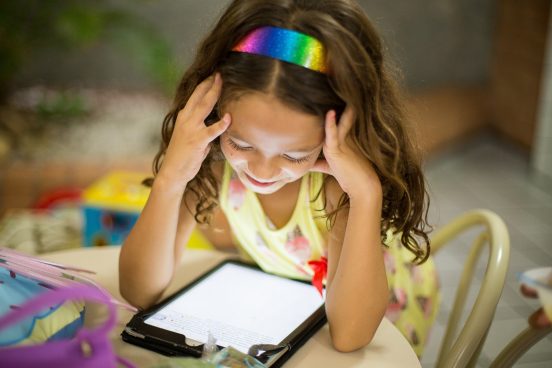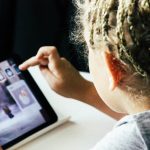This week I investigated further into my inquiry, engaging parents of early French immersion children with a variety of multimodal practices to help support their children in literacy. I came across an article of a collaborative action research project that investigated the use of mobile technologies and their impact on second language acquisition. Teachers were given iPads and iPods and collaborated and reflected on the usage of the mediums in the classroom.
In French immersion programs, we are seeing a vast increase in enrollment with ranges of diversity. This increase is resulting in a variety of needs and complex learning styles. The diverse needs warrant changes in the French immersion program to best meet the needs of every student. According to Gaudet (n.d.), differentiating instruction and providing accessible learning environments are challenging and this is primarily due to the lack of technological devises in the classroom to help support the varying needs (Gaudet, n.d.). To differentiate language learning, using mobile devices is necessary in the classroom to help model language and to allow for student creation of content, student and teacher feedback, and parent involvement. According to the study, teachers, students and parents had an overwhelming positive reaction to the implementation of the devices in the classroom (Gaudet, n.d.).
The article provided me with three major themes that I can use to continue gathering evidence for my inquiry in this subject:
- French language acquisition
For a French immersion learner to retain information, according to Gaudet (n.d.), lessons need to be multi-sensory so that there are more complex cognitive pathways provided to each student. The information learned is associated to past, present and future experiences and the implementation of the technological devices into the classroom enriches these practices (Gaudet, n.d.). For example: in the research project, students used iPods and iPads to record and video themselves speaking or reading a book in French. Students would record their process, hear it back and re-record if errors were made. The teachers had access to the audio or video recordings to formatively assess the student learning and to provide immediate constructive feedback. This tool also allowed for parents to access their child’s recording to help assist at home. This process is very collaborative and allows for enhanced opportunities for students to co-construct knowledge, use new vocabulary and verbalize their learning with self, peers, teacher and parent (Gaudet, n.d.).
According to Gaudet (n.d.), the teachers in this study also commented on the devices providing significant aid to the reluctant, shy or struggling learners. The tools provided students an opportunity to use at their own pace without judgment of peers. Their confidence in speaking French had improved.
- Assessment practices
Many teachers in this project remarked that the devices transformed their assessment practices. Their assessments were more child-centered and authentic. It provided evidence of the child’s oral language development and teachers had significant access of data from the audio and video recordings. Teachers gave feedback on the student’s oral language skills, providing adequate opportunity to reflect, re-record and refine their work which accelerated their language development (Gaudet, n.d.).
Teachers also reported feeling positive with the emerging reading processes with primary learners. The devices allowed for teachers to know where exactly their students were as readers and what next steps were needed to help with their reading. According to Gaudet (n.d.), the mobile devices also allowed for easy sharing with families through apps such as Dropbox. Teachers were able to send parents the audio or video recording file and parents could discuss and celebrate the learning at home in an immediate way (Gaudet, n.d.).
- Mobile devices as tools to accelerate student learning.
The role of mobile devices in accelerating student learning were overwhelmingly positive according to the teachers in this research project. Students were actively engaged and were excited using the devices when embedded into instructional practice. Students were proud of their work and they appeared to have had less anxiety and stress due to the tools ability to facilitate multiple attempts at oral language tasks (Gaudet, n.d.).
Teachers also reported increased levels of focus on reading tasks as well as general increased levels of independence. The tools empowered student learning and gave parents access to help accelerate reading and oral speaking at home. Recording and video apps provide feedback from self, peer and guardian. Video and audio recording are a great way to capture language learning in action (Gaudet, n.d.).
Dropbox
Dropbox can be a great teaching/learning tool – and therefore I am going to inquire on whether this tool should be used in my class. According to the app, students can share their recordings which can be shared with their parents to help support them at home. According to the app, you create a sharing folder for each child and when students are ready to share their work, they can upload it into their file – making it available to all parties.
In my class I am using FreshGrade, an app that I use to upload student work and video and audio recordings. Parents have enjoyed seeing their child’s work, often leaving comments regarding their progress.
I agree with Gaudet, devices are necessary to help model language, but it also increases student engagement and it differentiates language learning. It also allows for student creation of content, student and teacher feedback, and parent involvement. When learning a second language it is important to keep those learners hooked, engaged, and excited on what they are learning!
Photo by Patricia Prudente on Unsplash
Gaudet, G. (n.d.). Using Mobile Technologies in French Immersion Classrooms: Enriching Second Language Acquisition.
Dropbox: A Superb Classroom Tool. (2012, August 10). In The How of 21st Century Teaching, Voices, Web Tools That Deepen Learning . Retrieved from https://plpnetwork.com/2012/08/10/dropbox-a-superb-classroom-tool/





mrsandersenswestcoastclassroom
October 21, 2019 — 9:41 pm
Hi Sarah,
Thanks for the information. I really like the idea of students recording their voices and then being able to send it to their parents. I’m not sure how easy Dropbox is but let us know how it all works out. In my experience, the majority of parents love to hear their young children read and I think this a great way to get parents involved. It is a good way for parents to understand what their child is able to do and hear a current example.
laucoo
October 26, 2019 — 10:59 am
Thanks for sharing Sarah! It looks like you found some great information and it can be used to share with families to justify why you are using technology in your classroom! 😉